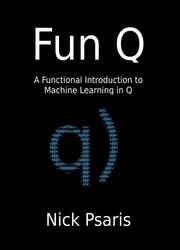 Название: Fun Q: A Functional Introduction to Machine Learning in Q Название: Fun Q: A Functional Introduction to Machine Learning in Q
Автор: Nick Psaris
Издательство: Vector Sigma
Год: 2020
Страниц: 415
Язык: английский
Формат: pdf, azw3, epub
Размер: 10.1 MB
Bring the power of Machine Learning (ML) to the fastest time-series database. Fun Q uses the powerful Q programming language to implement many of the most famous machine-learning algorithms. Using a meticulously factored machine-learning library, each algorithm is broken into its basic building blocks and then rebuilt from scratch. Famous machine-learning data sets are used to motivate each chapter as advanced Q idioms are introduced. Whether you are a data scientist who is new to Q or a kdb+ administrator who is new to Machine Learning, you'll have fun learning how machine-learning algorithms can be implemented in the concise vector-functional language Q.
With nothing but the Q binary, you'll be able to download data sets, generate plots in the Q terminal and get progress-bar-style feedback as model parameters iteratively improve. In addition to being a functional introduction to Machine Learning algorithms in Q, it is designed to be a fun introduction as well!
Who is This Book For?
This book assumes an introductory knowledge of kdb+. It also assumes you have Q installed (or know how to install it). Most Q developers use the language to build tickerplants, databases or CEP engine. Few use Q as an analytics platform, however. This is beginning to change. This book is for the community of developers who, like me, have fallen in love with programming in q and want to extend their computing knowledge into the world of big data and machine-learning algorithms while simultaneously learning how to write better Q. It is also for the data scientists who find that the data they need - or want - to analyze is increasingly being stored in a kdb+ database. Using their existing machine-learning knowledge, they will be able to learn q programming idioms that will improve their ability to write efficient code.
Скачать Fun Q: A Functional Introduction to Machine Learning in Q
|